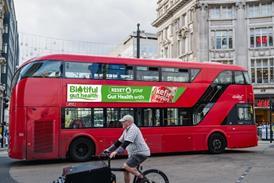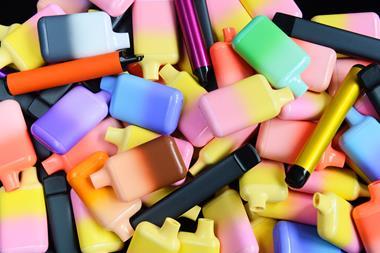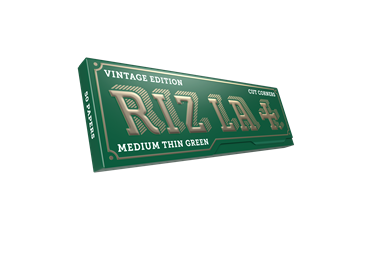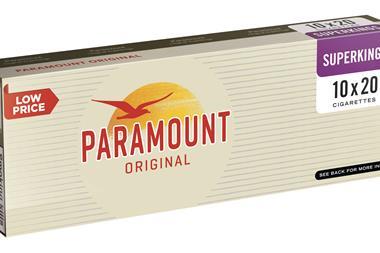Legislation changes have made the e-cigarettes category a tricky one to navigate, but it’s well worth getting astute with the subject.
May 20 was the final deadline for getting on board with the snappily-titled European Tobacco Product Directive 2 – the EU’s latest attempt to regulate the formerly fairly free-wheeling e-cigarette market.
In many ways it marks the maturity of the category. The wacky flavours, iffy knock-offs of well-known brands and super-high nicotine products that marked the industry’s growing pains should now be long gone in stores.
Post-regulation there’s fewer players as the fly-by-night merchants fade and, the regulators hope, a sector that plays by similarly stringent rules as tobacco.
It’s great news for campaigners who worried that the vaping boom was a smoke-screen for potentially harmful products. But for retailers the question remains: will the new rules put out the fire that’s been fuelling vaping’s phenomenal growth?
According to Nielsen, sales of e-cigs soared 22.2% between 2015 and 2016, as the number of vapers doubled over the same period. It’s not often that a new category grows so fast – and many retailers were counting on it shoring up their embattled cig offer.
Hard-working staff aren’t exactly known for loving new regulation (especially if it annoys regulars and curtails sales). However, rather than killing off the category, some c-store professionals say that regulation might actually clear the smoke around what can be a complex sector.
“I think that the government changes have actually clarified a lot,” says Sam Coldbeck from Wharfedale Convenience Store in Hull.
“The category is very young and the latest raft of changes that came into force on May 20 have helped everybody get in line.”
Manufacturers agree. Jennifer Roberts, VP customer marketing at Blu UK, says: “Overall, EUTPD II has forced everyone to take a fresh look at what they are making and what they are selling. The result should be higher-quality products and better safety across the market, which can only be a good thing.”
For Sam, vaping products are a “crucial” part of her c-store offer. Currently, she has about five metres dedicated to vaping essentials and is supplied by Real Trading – and she says the updated regulations have helped her focus on streamlining the range to concentrate on what sells well.
“We went from a height of about eighteen months ago offering a lot of flavours, to really fine-tuning our offer in line with the changes,” she explains.
“Now we just concentrate on the best-sellers. We’ve had to learn very quickly just because it’s such a fast-expanding market.
“We’ve got staff who vape and they’re really good at offering advice for customers. We have someone on each shift so if customers ask then there’s a person on the shopfloor who’s knowledgeable about the category. And that’s great – because I often haven’t got a clue!”
Many retailers (and a fair proportion of customers) can sympathise with Sam. A burning issue around the category’s expansion is the sheer breadth of products and formats, which has caused confusion. But the flipside of this is that as retailers become more confident, they’re able to give a better service to vape-seeking customers.
Harry Goraya, from Rosherville Post Office in Gravesend, Kent, says that one of the reasons vaping is “booming” in his store today is because he’s sure of his offer.However, he remembers the early days of the category when he wasn’t convinced even the brand reps really understood the market.
“I sensed that vaping was where the progression was and saw that the initial launches were an excellent margin,” he says.
“Initially, I was cautious and we just tried out a few – the big name brands such as E-lites and Blu. One thing I noticed was that the information wasn’t really clear. We all knew that it was going to kick off, as it had in other countries.
“I knew it was an emerging trend, but in retrospect I don’t think I had enough information to promote it as I would have liked.”
He adds that as the market has matured the situation has much improved. Plus, sticking with the big brands has meant he’s been able to supply high-quality products from a transparent supply chain – which fits in perfectly with his shop’s ethos.
The next step for Harry is fitting a specially-made gantry to better showcase his e-cigarette solutions.
“We’re not looking to have £100 units like you get in the vape shops, but we do want to go more mid-range with the category, maybe about the £20-£40 mark,” he says.
Steve Moore, head of global sales at vaping experts Smkd, says retailers need to provide education to their sales staff at the counter so they can offer the right advice, otherwise the customer will turn to a specialised store.
Over at Farrants in Cobham, David Worsfold agrees that the key to unlocking the category is “training and knowledge”.
“One of the things our company always says is that if you do a product then you’ve really got to own it,” he maintains.
“We’re not in a busy thoroughfare so we don’t get lots of impulse buys; it’s about stocking those products that really pull the customers in.”
David’s experience with e-cigs started way back in 1995 with a German brand (“they didn’t work at all – the market wasn’t there yet!”, he chuckles). Much later this was followed by a thorough investigation into the sector and what makes it tick, which ended with a supply deal with Liberty Flights.
“We understand their products inside out and they’ve invested heavily in making sure that all their range meets the new regulations,” he says. “That allows us to take the customer on a bit of a journey. These days all the early adopters have already got their hardware. So the biggest sale for us is going to be the refills.
“And after that we can maybe move them on to the double coils and other variations. With the right training, Liberty Flights have allowed us to do that.”
Blu UK’s Roberts says the company has seen continued movement in the market towards open (tank) systems and e-liquid refills – “to the extent that nearly half of all sales are now through open system products (48.8% in the 12 weeks to 25 February 2017) vs 40% in the same period last year. Sales of e-liquid refills also reflect this shift towards open systems with value sales up 50% year on year.”
Moore at Smkd pinpoints disposable pod devices as a sub-sector that will appeal to newcomers to the vaping category.
However, he believes that refillables will continue to appeal to the largest proportion of vapers, especially on-trend brands such as Aramax Vaping Juice.
They also provide the opportunity for repeat purchases, and the regular basket boost this can bring.
“Vaping is based around a FMCG product and convenience is all about FMCG products,” he says.
David Worsfold also sees refillables as the foundation for vape sales. Despite the EU crackdown he believes that there’s still enough options available to meet most vapers’ needs.
In addition, he thinks that what he calls the “vaping aficionados”, who demand more sophisticated products, aren’t necessarily where the c-store market is. “I believe that they tend to do business online,” he says, “although that will soon be changing, too, as the regulations have an affect on what they’re allowed to buy on the internet.”
As Sam explains, often what shoppers want is dictated by price. “Our store is in a socially-deprived area, so price is important for us and our customers,” she says.
“We always make sure we have well-priced products that come in about the £3.99 price point (such as Aqua Lites) or £2.50 (such as KiK).
“We have tried £9.99 packs, but that’s just too high a price for our customers. At the end of the day, it’s about knowing your demographics and understanding your market.”
Harry believes the continual price increases of standard cigarettes have helped make e-cigs a more appealing value proposition. In particular, he thinks that the death of the 10-pack format and cigarettes at £10 a packet have pushed people into finding more cost-effective options such as e-cigs.
He tells the story of a regular customer, “a 40-fags-a-day man” who particularly benefitted from a switch to e-cigs. “Basically, he hadn’t been on holiday for the past ten years, so I just asked if he’d tried the e-cigs at £10 for the unit and £3.99 for liquid for the week,” says Harry. “He ended up putting the money he’d otherwise spend on fags in a jar. He couldn’t believe how much he saved.
“He went on holiday last year and he’s going again this year. That’s great – we want long-term relationships with our customers and we’ve been able to save him cash while he carries on doing something he enjoys.”





















![92611-Golden-Virginia-BTO-5x40g_3D-Soft-Pack_L[39]](https://d2dyh47stel7w4.cloudfront.net/Pictures/380x253/8/9/4/340894_92611goldenvirginiabto5x40g_3dsoftpack_l39_10582.png)






No comments yet